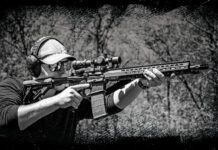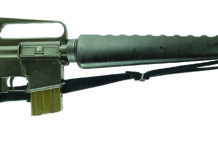For a number of years after its civilian introduction in 1964, the Colt AR-15 was essentially a semiautomatic version of the U.S. military’s standard issue rifle, the M16. Today, however, a handful of manufacturers are producing AR-15-type firearms in a variety of configurations. We prefer to call these firearms sporting rifles.
Despite what some politicians may think, we feel that all law-abiding citizens of this country should have the opportunity to own a sporting rifle. They are suitable for many types of shooting activities, from small game and varmint hunting to target shooting and home protection. They are also just plain fun to shoot.
All of the rifles in this test are .223 semiautomatics based on the AR-15 design. They are the ArmaLite M15A2 HBAR, the Olympic PCR-4 and the Colt Match Target HBAR. Each has a heavy 20-inch barrel, a two-piece alloy receiver with a nonremovable carrying handle and a synthetic stock. The round two-piece handguard on each rifle has an internal aluminum heat shield.
The Rifles
The ArmaLite M15A2 HBAR has a suggested retail price of $930. Its heavy barrel is rifled with a 1-in-9-inch twist. There is a device attached to the front of the barrel, which the manufacturer calls a recoil check, that acts like a muzzle brake. This rifle’s synthetic stock is olive green. One 7-round magazine, a 1-inch black nylon sling and an operator’s manual are provided with this model.
Retailing for $858, the Olympic PCR-4 has a heavy barrel rifled with a 1-in-9-inch twist. Nothing is affixed to its muzzle, but there is a groove around the front portion of the barrel for mounting an aftermarket accessory. The synthetic stock is dull black. Packed in a Gun Guard hinged plastic carrying case, this model comes with one 7-round magazine (made by ArmaLite), a 1-inch black nylon sling and an owner’s manual.
[PDFCAP(2)].The Colt Match Target HBAR features a heavy barrel with 1-in-7-inch rifling and a recessed crown. There is nothing on the muzzle. The synthetic stock is matte grayish-black. Items supplied with this $1,067 rifle are two 9-round magazines with extended black plastic bases, a chamber brush, a bore brush, a cleaning rod and an instruction manual.
[PDFCAP(3)].Observations
Our ArmaLite’s receiver had a blacker, richer-looking nonreflective finish than the other two rifles. A few insignificant tool marks were found on the rear interior of the bolt. The push-type pivot pin and takedown pin, which held the upper and lower portions of the receiver together, were very tightly fitted. So, the halves of the receiver had no play. There were a few minor cosmetic flaws along the edges of the handguard, and it had a moderate amount of play. The door to the storage compartment in the butt, which had a metal hinge and latch, worked positively. Overall, we considered this rifle’s workmanship to be the best of the test.
The Olympic’s metal finish wasn’t uniform. The upper part of the receiver was blacker than the lower part. A couple of minor tool marks were present on the underside of the bolt. Both of the push-type receiver pins were fairly well fitted, resulting in a minor amount of play between the upper and lower parts of the receiver. The stock had no cosmetic shortcomings, but the handguard had a small amount of play. The buttstock’s storage compartment had metal fittings, but its spring-loaded latch was very stiff. In our opinion, this model’s fit and finish wasn’t quite as good as that of the ArmaLite.
Externally, the Colt’s receiver had a uniform grayish-black finish. Internally, some shallow tool marks were noted on the upper part of the receiver and on the bottom of the bolt. There was a screw-type pivot pin at the front of the receiver and a push-type takedown pin at the rear. The halves of the receiver had significantly more play than the others in this test. The two-piece handguard was so tightly fitted to the slip ring that it was extremely hard to pull the ring down far enough to remove the guard for maintenance. The hinge and locking mechanism of the storage compartment in the buttstock were integral with the black plastic door, which we felt made its long-term durability questionable. We rated this rifle’s workmanship as average, the least desirable of the test.
Handling
Due to the ArmaLite M15A2 HBAR’s muzzle check, it was a few ounces heavier and a little more muzzle heavy than the other rifles in this test. This provided the best muzzle stability, but made target acquisition the slowest. The muzzle check also effectively reduced muzzle jump, which was the mildest of the test by a large margin.
Handling qualities of the Olympic PCR-4 and the Colt Match Target HBAR were nearly the same. Both rifles balanced and shouldered well. Muzzle stability was satisfactory. Target acquisition was a little faster than the ArmaLite. The Colt’s wider pistol grip afforded the most comfortable grasp. Our shooters said the Olympic seemed to recoil a little more than the Colt, but either rifle was easy to manage during rapid fire shooting.
Controls
Location and operation of the controls was the same on all of the rifles. The magazine release was a large button above the front of the trigger guard on the right side of the lower receiver. Right-handed shooters could depress it with their trigger finger. The bolt lock/release, a paddle-shaped lever above the front of the trigger guard on the left side of the lower receiver, was best operated with the support hand. The two-position selector lever, located above the pistol grip on the left side of the lower receiver, prevented firing by locking the internal hammer when in the “Safe” position. Right-handed shooters could manipulate this control with their dominant thumb, while left-handed shooters used their trigger finger.
Both sides of the ArmaLite M15A2 HBAR’s receiver were marked so that the shooter could tell what position the selector lever was in when looking at either side of the rifle. Movement of all the controls was the smoothest of the test. However, the trigger released at a very heavy 8-1/4 pounds, making it the heaviest of the test.
On the Olympic PCR-4 and the Colt Match Target HBAR, the words “Safe” and “Fire” were stamped into the left side of the receiver to indicate which position the lever was in. However, there were no markings on the opposite side of the receiver. The Olympic’s controls moved stiffly and felt gritty, but its 6-1/2-pound trigger pull was the lightest of the test. The Colt’s controls were nearly as smooth as those of the ArmaLite, but its trigger released at a heavy 7-1/4 pounds.
Sights
Each of the three rifles was equipped with E2-style open sights. The square post front sight, which was mounted on an A-frame and protected by side guards, could be rotated for initial elevation adjustments. The rear sight, located on the back of the carrying handle, consisted of a pivoting two-aperture peep on a click-adjustable base. The rear sight could be readily adjusted for windage and yardage/elevation by turning the appropriate adjustment knob. We thought this system afforded a good sight picture, so we used it during accuracy testing. The carrying handle on the each rifle was designed to accommodate an AR-15-type base for mounting an optical sight.
The ArmaLite’s rear sight had the best and clearest markings. Positions on the windage knob were numbered, instead of just notched, for repeatable settings. The elevation wheel had markings for both yardage and elevation adjustment. Movement of the windage knob was a bit stiff, but it and the elevation wheel had positive clicks.
The rear sight on the Olympic had the least markings, and the markings were so shallow that they were the hardest to see in low light. The windage knob had index notches only, so it was difficult to tell if we had correctly moved the knob to a previous setting. The elevation wheel had elevation markings, but no numbers for setting the yardage. The wheel worked smoothly, but the windage knob’s movement was extremely stiff.
Markings on the Colt were nearly as good as those of the ArmaLite. The windage knob had index notches only, but the elevation wheel had both yardage and elevation settings. Both the knob and the wheel moved smoothly and weren’t overly hard to turn.
At The Range
None of the rifles malfunctioned even once with the three kinds of commercial ammunition we tried. Extraction of fired casings was smooth. Ejection was strong and consistent. All of the magazines loaded to capacity with in minimum of effort.
Retracting the ArmaLite M15A2 HBAR’s bolt required the least effort of the test. It seemed like this rifle’s recoil spring applied less tension to the bolt than the others. Operating the Olympic PCR-4’s bolt required the most muscle, though we didn’t consider it to be overly stiff. The Colt Match Target HBAR’s bolt worked the smoothest, requiring only a moderate amount of effort to operate.
[PDFCAP(4)].During accuracy testing, the ArmaLite was the best performer. Its smallest three-shot average groups, 1.60 inches at 100 yards, were obtained with Winchester 64-grain Power Point soft points. Federal Classic 55-grain full metal jacket boattails were good for 1.85-inch groups. UMC 55-grain metal case ammunition managed 1.97-inch groups. For more detailed information, see the performance table on page 21.
The Olympic was almost as accurate as the ArmaLite with two of the three loads we used. This rifle’s best average groups, 1.72 inches at 100 yards, were produced with the Winchester 64-grain ammunition. The Federal 55-grain load yielded 1.85-inch groups. The UMC 55-grain load managed groups that averaged 2.28 inches.
None of our shooters were satisfied with the Colt’s accuracy, which finished a distant last in this test. The Federal 55-grain load achieved average groups of 3.58 inches at 100 yards. The Winchester 64-grain load and the UMC 55-grain load produced groups measuring 2.68 and 3.13 inches, respectively.
Field Stripping
Each of these .223 semiautomatic rifles field strips in the same manner. Doing so is easy and doesn’t require any special tools. First, eject the magazine and unload the chamber. Push the takedown pin, located near the rear of the lower receiver, from left to right with a blunt object. Pivot the lower receiver open. Pull the charging handle rearward about three inches, withdraw the bolt carrier group from the upper receiver, then completely remove the charging handle. Separate the upper and lower receivers by removing the pivot pin that passes through the front of the receivers. Remove the firing pin retaining pin, the firing pin, the bolt cam pin and then the bolt from the bolt carrier. Reverse these steps to reassemble.





























